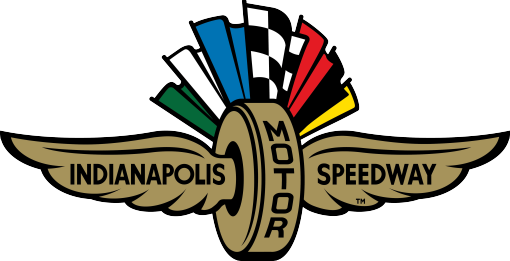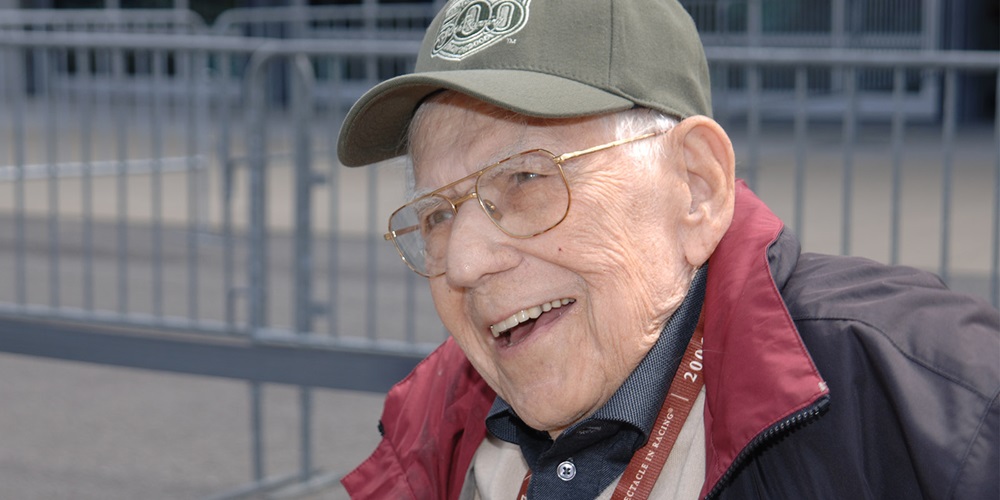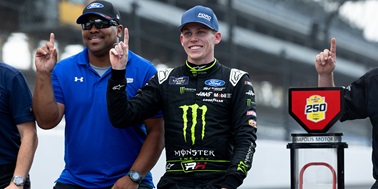“AND HEEEEEE’S ON IT!!”
The booming baritone voice of Tom Carnegie thrilled millions upon millions of spectators at the Indianapolis Motor Speedway for decades. The legendary chief announcer of the public address system formally relinquished his duties after the 2006 Indianapolis 500.
The voice of Carnegie was first heard over the P.A. on Race Day in the 1940s, and by the mid-1950s it had become one of the track’s most recognizable and cherished attributes.
He probably deserves more credit than any other single human being for the building of the gigantic crowds which used to flock to qualifications during the days when the breaking of the track record was almost an annual occurrence. While it was certainly the drivers who were out there breaking the records, it was the dramatic commentary by Carnegie which stirred the crowd and led them to spreading the word, thus creating an even larger attendance for the following year.
Bringing Theater to Indy
While he was growing up, Carnegie aspired to be an actor, but those dreams were effectively dashed during his college days when he was stricken with polio. Instead, he regrouped and began focusing on using his extraordinarily rich voice for commentating at sporting events, his sense of the dramatic paying dividends for him.
“It’s theater,” he has always said of the Speedway, chuckling at the memories of some of his more famous calls, when spectators had to rely solely on his commentary for clues as to what was occurring in areas of the track hidden from their view.
He always relished the private moments when he would learn of an exciting development and then have a second or two in which to contemplate how he was going to announce it. He loved “working the crowd,” and its reaction was his reward.
Fate eventually led him to a radio station in Indianapolis near the end of World War II, and it was while he was "emceeing" at a vintage car concourse just days before the 1946 "500" that new track president Wilbur Shaw heard his work, and invited him to assist with the "P.A." on Race Day. Carnegie accepted and kept coming back for the next six decades.
It was on that May day in 1946 that Carnegie's incredible baritone was first heard over the track's loudspeaker system, later to coin and develop such iconic phrases as, "AND HEEEEEEE'S ON IT!" "HEEEEEERE'S THE TIME AND SPEED REPORT!" and, of course, the classic "AAAAAAND, IT'S A NEEEEEW TRACK RECORD!"
He developed his style through the mid-1950s and pretty much had it perfected by the early 1960s, bellowing the aforementioned phrases, and others, to the delight of the crowd. He enjoyed tantalizing the attentive throng by "telegraphing" a new track record or a spectacular speed with setup lines like, "YOU WON'T BELIEVE IT!" or, in the case of a run in which the speeds were increasing with each lap, "AAAAAAND, IT'S STILL GOING UP!"
Because of his sense of the dramatic, and the fact that it had not been possible for any spectator to see completely around the massive facility, he enjoyed toying with the imagination of the IMS crowd with lines like, "WHO WILL IT BE? WHO WILL IT BE?" Or on a relatively peaceful qualifying day, while waiting to see if a driver was or was not going to raise his hand for a qualifying run, "Let's wait and watch," with a little singsong rise and fall to the last word. This would likely be followed up by, "Heeeeere he comes," delivered with an upward glissando for "here" and a two-note singsong for "comes."
Privately, Carnegie became somewhat saddened in the 1990s when almost instant timing and scoring information became available to the public via computers, followed by the installation of large television screens around the track. He felt these innovations might tend to lessen the mystique.
Perhaps his favorite "call" came in the closing moments of the 1967 race when Parnelli Jones had to drop out with Andy Granatelli's turbine after having led for much of the day, setting up the stage for A.J. Foyt to become a three-time winner.
Moments before Foyt was due to come through Turn 4 for the final time, a multi-car accident took place on the main straight, all but blocking the track. While cars were spinning in every direction—and, unknown to Carnegie, Foyt, with his incredible sixth sense, had already slowed down—Carnegie was bellowing, "HE SHOULD BE COMING INTO SIGHT AT ANY MOMENT. WILL HE GET THROUGH? WILL HE GET THROUGH? WHERE IS HE? WHERE IS HE? followed by a triumphant, "THERE HE IS!!!"
Going Out On Top
He never really wanted to quit, but understandably found himself tiring more easily upon entering his 80s. Realizing that the dramatic finish to the 2006 "500" would be hard to top—Sam Hornish Jr. seemingly came out of nowhere to pip rookie Marco Andretti at the start/finish line – Carnegie decided to call it a career.
He would continue to come to the track as a visitor during event times and be besieged by race fans of all ages who wanted to share their memories and thank him for his contributions. Carnegie passed away in February 2011, just three months before the 100th anniversary of the Indianapolis 500, at age 91.
Carnegie’s contributions spread far beyond the Indianapolis Motor Speedway. He was covering qualifications for the inaugural Ontario (Calif.) 500 in 1970 for what was then WFBM-TV (now WRTV), of which he was the longtime sports director, when he was quickly pressed into service. Alarmed by the lackluster performance of the local track announcer after just a couple of qualifying runs, and knowing the master was close by, it didn't take long for the organizers to call Tom to duty.
Carnegie traveled the circuit for a couple of years after that, announcing all of the United States Auto Club national championship races. He was a real friend to USAC, as well as to the Speedway, never failing to show up for any kind of press announcement over a period of many years and always willing to interview a driver on camera about an upcoming race.
He was eventually to be inducted into a variety of Halls of Fame, in the fields of both motor racing and broadcasting.
What passion that man could stir. Who else would be able to open a microphone at 8 a.m. on a Saturday morning of qualifications, when nothing was happening, and with a simple, “Testing, one, two, three. Good morning, ladies and gentlemen,” be greeted by a roaring cheer?
The impact of Tom Carnegie has been immeasurable, and his work will never be forgotten.




